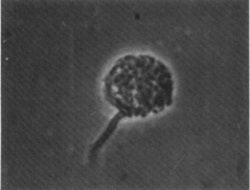Biology:Actinoplanes italicus
Actinoplanes italicus is distinguished by the cherry-red color of its vegetative mycelium, and by the production of soluble pigments. It is also known to produce sporangia when cultured on starch or skim milk agar. Very few strains have been found and cultured, thus A. italicus is relatively uncharacterized.
| Actinoplane italicus | |
|---|---|

| |
| Picture of A. italicus producing sporangia | |
| Scientific classification | |
| Domain: | |
| Phylum: | |
| Class: | Actinobacteria
|
| Order: | Micromonosporales
|
| Family: | |
| Genus: | |
| Species: | italicus
|
| Binomial name | |
| Actinoplanes italicus Beretta 1973
| |
Characteristics
- Optimum growth temperature is 26 °C
- Optimum growth medium is oatmeal agar
- Respires aerobically
- Gram-positive and motile
- Pathogenicity and other health effects are unknown
Discovery
A. italicus was discovered and isolated from a soil sample obtained from an orchard at Pontelongo, Italy.
Laboratory studies
During experiments led by Grazia Beretta searching for antibiotic producers from some of the uncommon genera of the Actinomycetales, A. italicus did not produce any antibiotic activity against either Gram-positive or Gram-negative bacteria, and differed in its morphological, cultural, and physiological characteristics. Studies were undertaken to determine whether the first strain, A 52212, of A. italicus represented a new species of Actinoplanes.
Materials and methods
A. italicus was cultivated using various standard media to determine optimum growth conditions. The media were incubated in the dark at 28 °C. Pigment production was determined by exposing the media to daylight and artificial light at night. Stock slant cultures were kept on oatmeal agar. Every 8 to 16 days, the colony characteristics were observed on starch agar Petri dishes.
Using A Dictionary of Color by Maerz and Paul, color was determined and assigned to the varying pigments produced. Carbon sources were investigated. The media containing carbon sources were inoculated with mycelium, washed twice, and suspended in distilled water. Optimal temperatures were determined by incubating slants of oatmeal agar at 15, 20, 28, 40, and 50 °C.
Macroscopic examination
The notable cherry-red vegetative mycelium is produced on most of the media used in the experiment. Other members of Actinoplanes, when grown on the same media, produced a yellow and orange vegetative mycelium.
Microscopic examination
The vegetative mycelium is composed of thin and twisted hyphae. The sporangia produced on starch and skim milk agar have wrinkled surfaces and vary in shapes from spherical to oval and piriform.
The shape of the sporangia takes on a more regular shape immediately before rupturing. The spores released are highly motile, taking on varying shapes of spherical and oval.
Physiology
In peptone-yeast extract-iron agar, A. italicus produces H2S. Within a skim milk agar medium, it was able to hydrolyze casein. Other notable physiological characteristics include its ability to liquefy gelatin, produce tyrosinase, and peptonization without coagulation. The optimal temperature ranges between 28 and 37 °C.
Carbon source
A. italicus uses inositol, fructose, rhamnose, mannitol, xylose, arabinose, sucrose, and glucose as carbon sources for growth. It differs from many members of its genus such as A. utahensis and A. missouriensis, which do not use inositol; from A phillipinesis and A. armeniacus, which use raffinose; and from A. brasiliensis and A phillipinesis, which usw cellulose. A. italicus is also noted to use natural rubber as a sole carbon source.
Soluble pigments
When cultured in different growth media, A. italicus tends to produce varying soluble pigments based on its carbon source. On some media, such as nutrient agar, calcium-malate agar, and Bennet's agar, A. italicus does not produce any pigment at all. On oatmeal, starch, and skim milk agar, the characteristic cherry-red pigment is produced. An amber color is produced when the organism is cultured on Hickey and Tresner agar, potato agar, and nitrate broth, whereas glucose asparagine agar and tyrosine agar would result in a pink color. A deep orange yellowish pigment is produced by growth on Czapek glucose agar.
Phylogeny
A. italicus belongs to the phylum Actinobacteria. It is most closely related to Actinoplanes couchii with 98.9% similarity using DNA-DNA hybridization.
Actinoplanes
Actinoplanes belongs to the family Actinoplanaceae. Some characteristics of this genus include able to form motile spores, as well as aerial mycelia and spherica. They are useful in that they can produce ramoplanin, teichoplanin, and valienamine, all of which are critical for the pharmaceutical companies. They generally produce a yellow or orange vegetative mycelium and ordinarily do not produce soluble pigments.
See also
- Sporangia
References
- Kampfer, P., Huber B, Thummes K, Grun-Wollny I, Busse H. Actinoplanes couchii sp. nov. International Journal of Systematic and Evolutionary Microbiology. April 2007. 57:721-724 doi:10.1099/ijs.0.64805-0. http://ijs.microbiologyresearch.org/content/journal/ijsem/10.1099/ijs.0.64805-0
- The Lab Rat. http://www.thelabrat.com/protocols/Bacterialspecies/Actinoplanesitalicus.shtml%7Caccessdate=12[yes|permanent dead link|dead link}}] November 2013
- Beretta, G. Actinoplanes italicus, a New Red-Pigmented Species. International Journal of Systematic Bacteriology. 1973 January. 23.1: 37–42. http://ijs.sgmjournals.org/content/23/1/37.full.pdf%7Caccessdate=13[yes|permanent dead link|dead link}}] November 2013
- Jendrossek, D. Bacterial degradation of natural rubber: a privilege of actinomycetes. FEMS Microbiology Letters. 17 2006 January. 150, 2: 179–188 http://onlinelibrary.wiley.com/doi/10.1111/j.1574-6968.1997.tb10368.x/full%7Caccessdate=13 November 2013
- Tree of Life Search. http://ikon.altervista.org/bionames/index.php?codtaxon=120224%7Caccessdate=12 November 2013
External links
Wikidata ☰ Q16973955 entry


